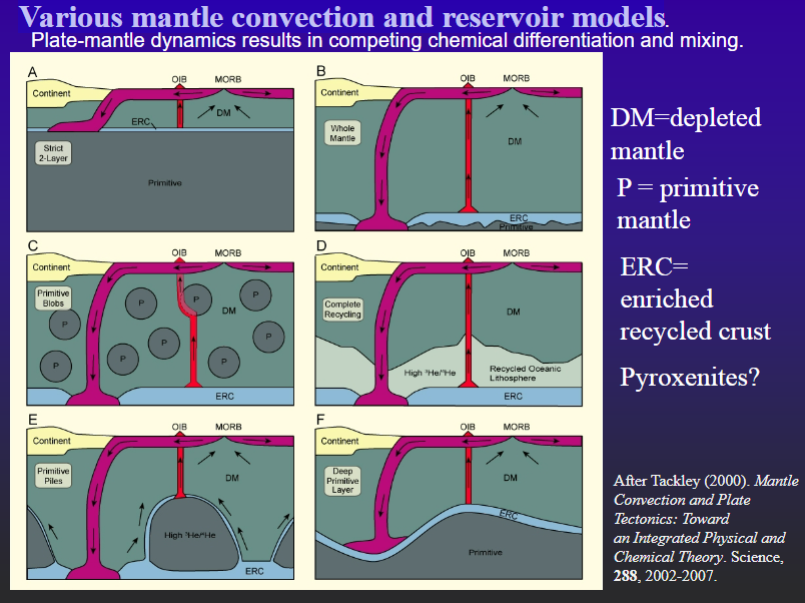Magma Generation
1/44
There's no tags or description
Looks like no tags are added yet.
Name | Mastery | Learn | Test | Matching | Spaced |
|---|
No study sessions yet.
45 Terms
Know the mineralogic characteristics of the upper mantle at different depths
Phase diagram for aluminous 4-phase Lherzolite
Aal-phase:
Plagioclase
-shallow (<50km)
Spinel
-50-80 km
Garnet
-80-400km
Si->vi COORD
>400 km
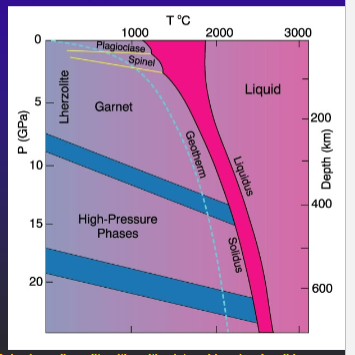
Classification of Volcanic Rocks Geochemical

Tholeiitic Basalt
Groundmass: Usually fine-grained, intergranular
No olivine
CPX= augite (plus possible pigeonite)
OPX (hypersthene) common, may rim OL
No alkali feldspar
Interstitial glass and/ or quartz common
Phenocrysts: Olivine rare, unzoned, and may be partially reorbed or show reaction rims of OPX
OPX uncommon
Early plagioclase common
CPX is pale brown augite
Alkaline Basalt
Groundmass: Usually fairly course, intergranular to ophitic
olivine common
titaniferous augite (reddish)
OPX absent
interstitial alkali feldspar or feldspathoid may occur
interstitial glass rare, and quartz absent
Phenocrysts: Olivine common and zoned
OPX absent
PLag less common, and later in sequence
CPX is titaniferous augite, reddish rims
Each Magma Series is chemically distinct
Evolve via FX as separate series along different paths
Tholeiites are generated at mid-ocean ridges
-Also generated at oceanic islands, subduction zones
Alkaline basalts generated at ocean islands
-Also at subduction zones
Magma generation
-What is melting? – Mantle lithology
-How does melting happen?
Heating, decompression, hydration
-What is produced by melting? – primary
magma at different pressure/ H2O contents
-Mantle heterogeneity and plate tectonics
Sources of mantle material
Ophiolites:
-slabs of oceanic crust and upper mantle
-thrust at subduction zones onto edge of continent
Dredge samples from oceanic fracture zones
Nodules and xenoliths in some basalts
Kimberlite xenoliths
-Diamond-bearing pipes blasted up from the mantle carrying numerous xenoliths from depth
Know the different mantle melting mechanism
Melts can be created under realistic circumstances:
Hot spots -> localized plumes of melts
Plates separate and mantle rises at mid-ocean ridges
-Adiabatic rise -> Decompression melting
Fluid Fluxing may give LVZ
-Also important in subduction zones and other settings
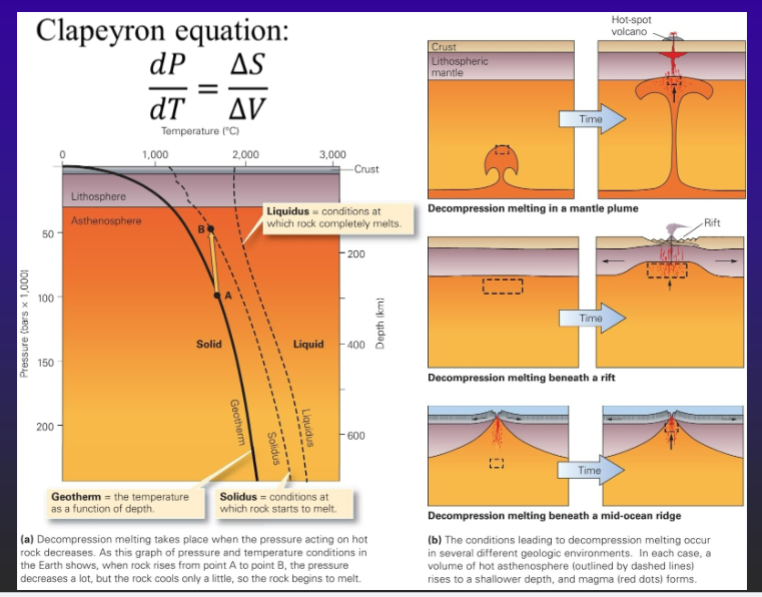
More complicated melting scenarios
Fluid induced melting and metasomatism of mantle wedge - arc magmatism
Crustal melting after basalt ponding at level of neutral buoyancy (LNB)
Rift related too

What happens to the solid when a rock is heated to ~ 1275°?
Partially melts
What will the first comp. of the first melt be?
-At E more Di-rich melt
What happens to the solid comp as melt is continuously formed?
-Solid becomes depleted in Di moves to An
Mantle melting
Any composition in this system starts to melt at the ternary eutectic E
-melt is multiply saturated with PL,OPX and CPX
As eutectic melt E composition is removed- solid residue moves toward OL-OPX boundary
Harzburgite melting at Ol- OPX cotectic after around 30% melt
Accumulated melt moves up to cotectic
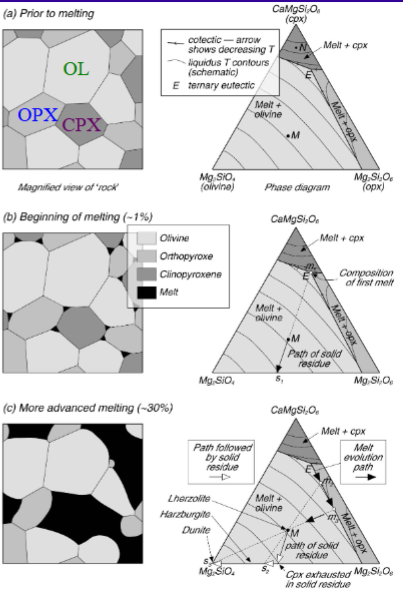
Decompression melting:
Can happen at mantle plume, beneath a rift, or beneath a mid-ocean ridge
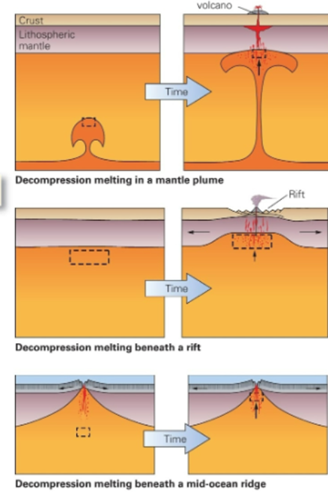
Fluid induced melting and metasomatism of mantle wedge- arc magmatism

Crustal melting after basalt ponding at level of neutral buoyancy (LNB) Rift related too.
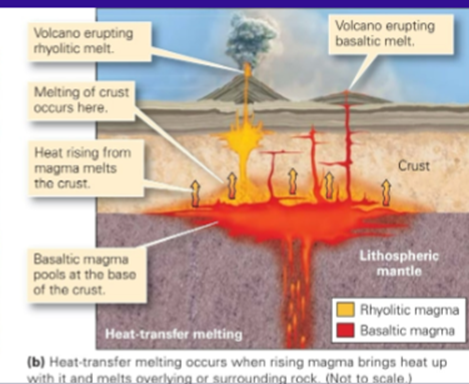
How does the mantle melt?
1. Increase the temperature- thermal plume
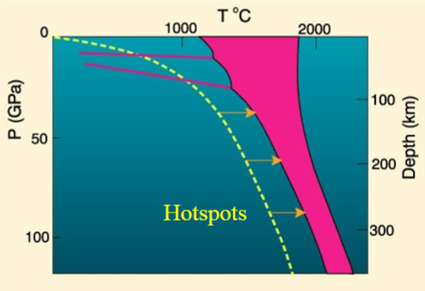
2. Lower the pressure
-Adiabatic rise of mantle with no conductive heat loss
-Decompression melting could melt at least 30%
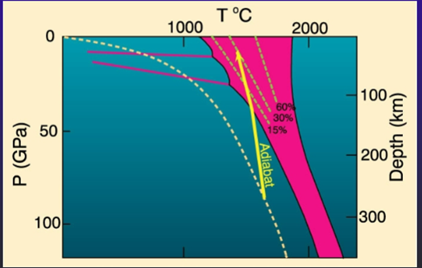
3. Add volatiles (especially H20) subduction zones
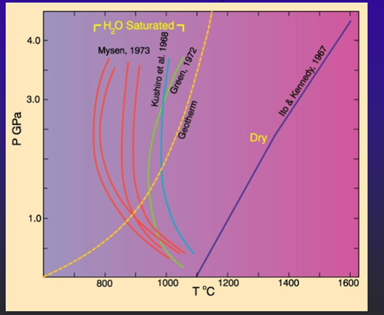
Melting at convergent margins:
Flux melting due to slab dehydration and water lowering the solidus of the overlying mantle
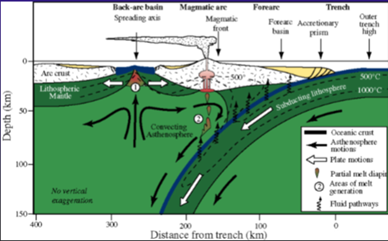
The Effect of water on melting
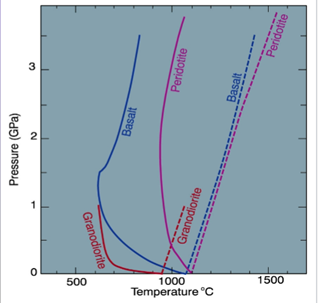
Dry melting: solid -> liquid
Add water, water enters the melt
The more mafic the rock the higher the melting point
All solidi are greatly lowered by water
Conclusion:
All though the addition of water can drastically reduce the melting point of rocks, the amount of melt produced at the lower temperature may be quite limited, depending on the amount of water available
We know the behavior of water-free and water-saturated melting by experiments, which are easy to control by performing them in dry and wet sealed vessles. What about real rocks?
Some may be dry, some saturated, but most are likely to be in between these extremes
-a fixed water content < saturation levels
-a fixed water activity (H20 relative to other volatile species, mostly CO2)
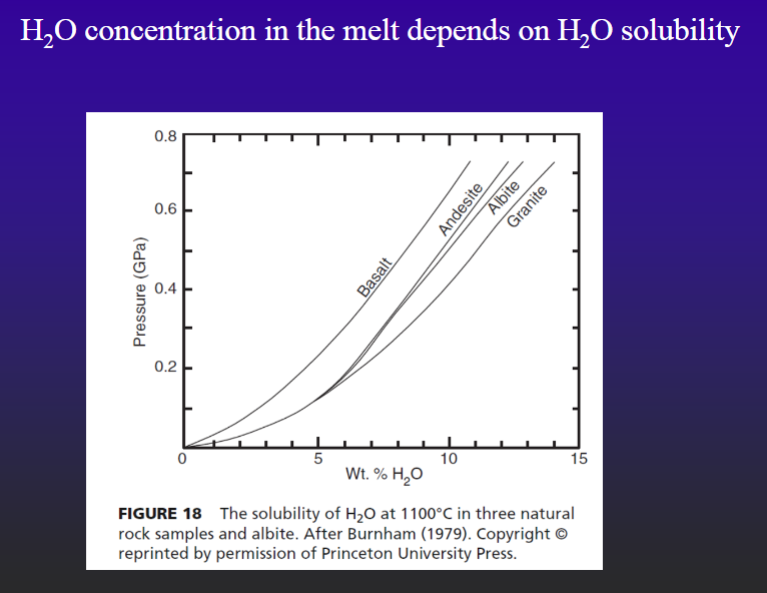
The Albite-Water System
Red curves = melting for a fixed mol % water in the melt (X)
Blue curves tell the water content of a water saturated melt
Conclusion:
All though the addition of water can drastically reduce the melting point of rocks, the amount of melt produced at the lower temperature may be quite limited, depending on the amount of water available`
Raise a melt with a ratio of albite:water 1:1
X melt water = 0.5
from a point a at 925C and 1GPa pressure, toward the earth’s surface under isothermal conditions
Conclusions:
-A rising magma with a fixed % water will progressively melt
-At shallower levels it will become saturated, and expel water into its surroudings
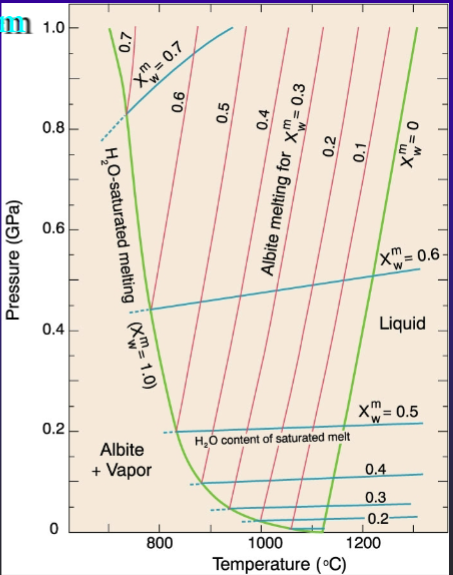
Melting of Albite with a fixed activity of Hfixed activity of H22OO
Fluid may be a CO2-H2O mixture with Pf=Ptotal
In many situations CO2 only acts to dilute the effects of water
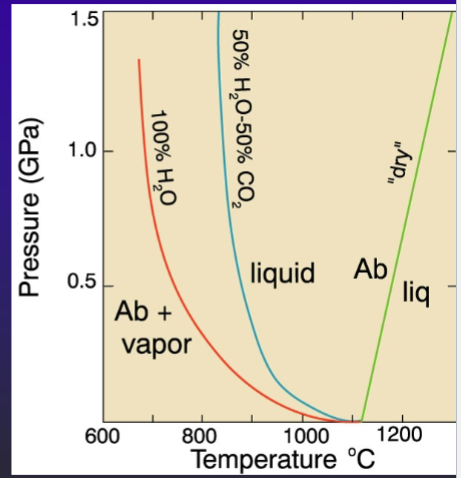
Heating of amphibole-bearing peridotite
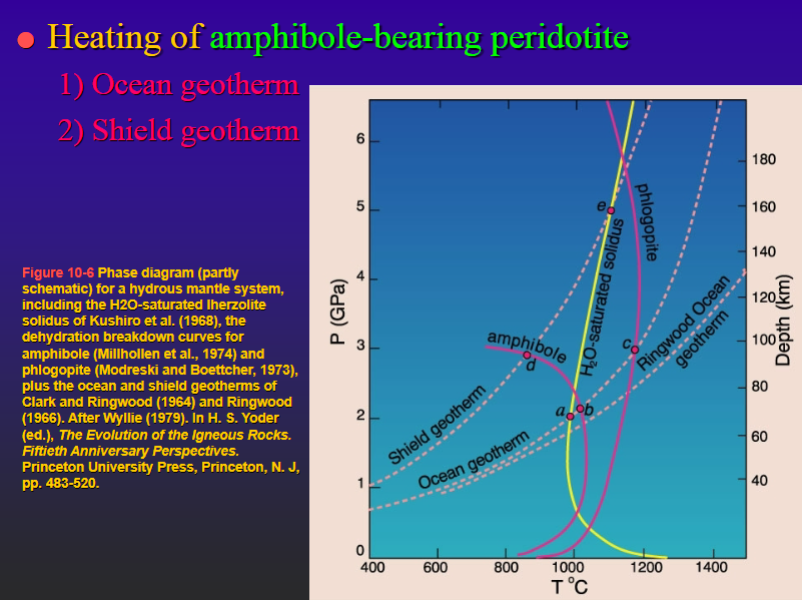
Island Arc Petrogenesis
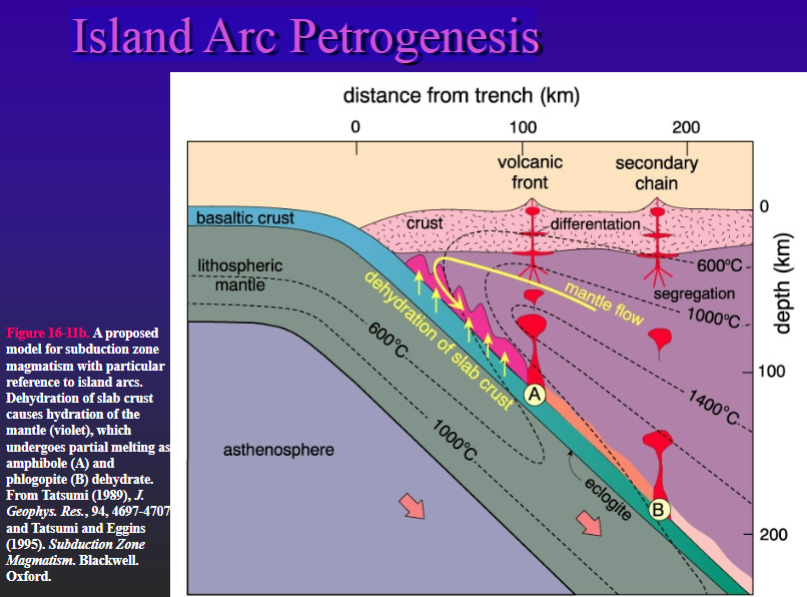
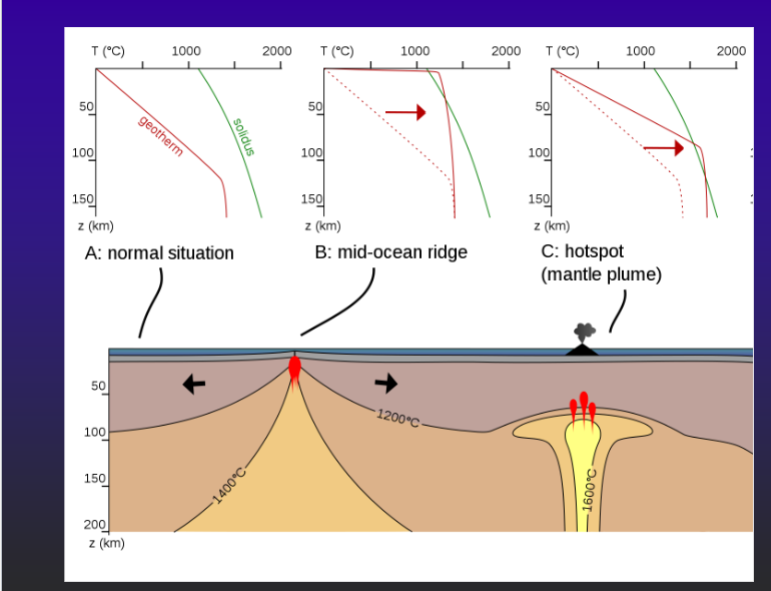
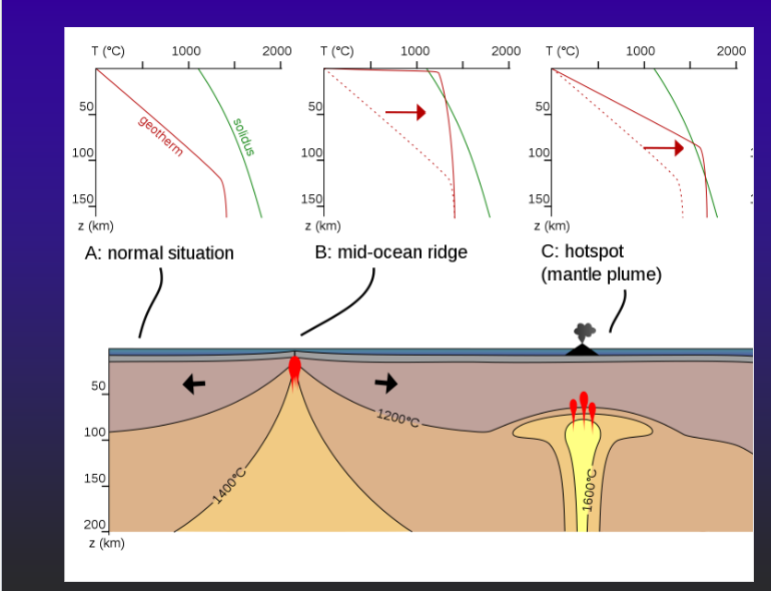
Effect of Pressure, Water, and CO2 on the position of the eutectic in the basalt system
Increased pressure moves the ternary eutectic (first melt) from silica-saturated to highly undersaturated alkaline basalt
Water moves the eutectic towards higher silica, while CO2 moves it more to alkaline types
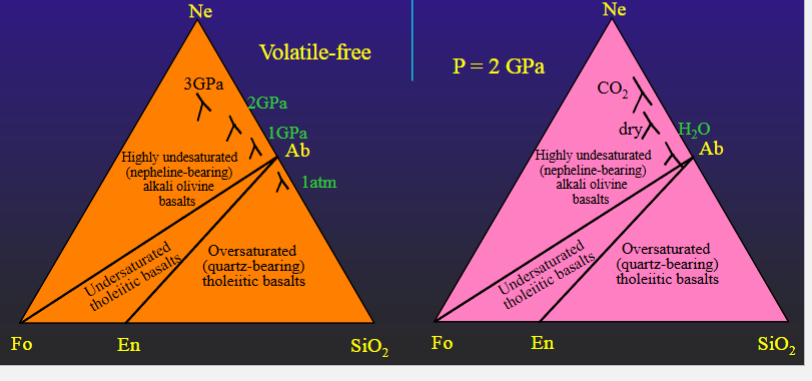
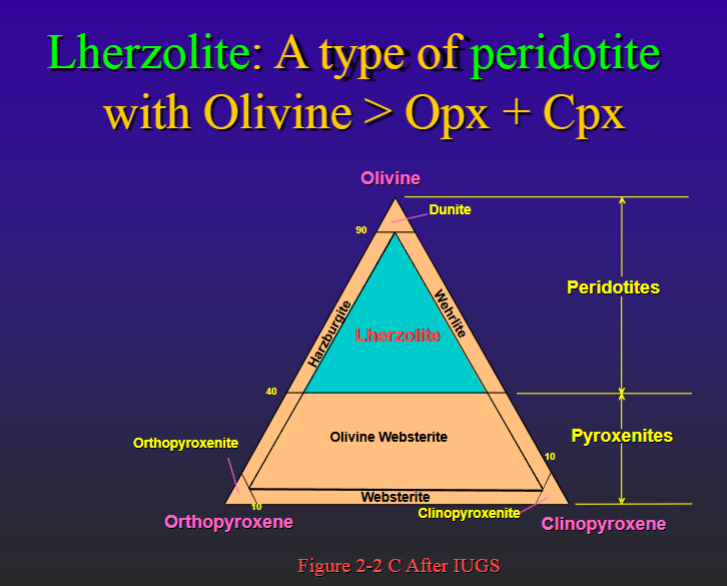
What’s the difference between a lherzolite and a harzburgite? A dunite?
Lherzolite: A type of peridotite with Olivine > OPX +CPX
Lherzolite is probably fertile unaltered mantle
Dunite and harzburgite are refractory residuum after basalt has been extracted by partial melting
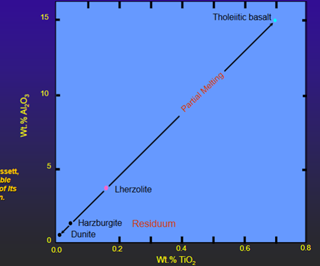
Which is considered “fertile undepleted” mantle. Which is the most refractory?
Understand the different origins of alkaline vs tholeiitic basalts from melting of either enriched or depleted mantle sources (i.e depth or melting, fraction of melting, etc.), and the petrographic distinctions between them
1. Depleted Mantle
-Tholeiite easily created by 10-30% PM
-more silica saturated at lower P
-Difficult to generate alkaline basalt
2. Enriched mantle
-Tholeiites extend to higher P than for DM
-Alkaline basalt field at higher P yet
And lower % Partial melt
REE data for oceanic basalts
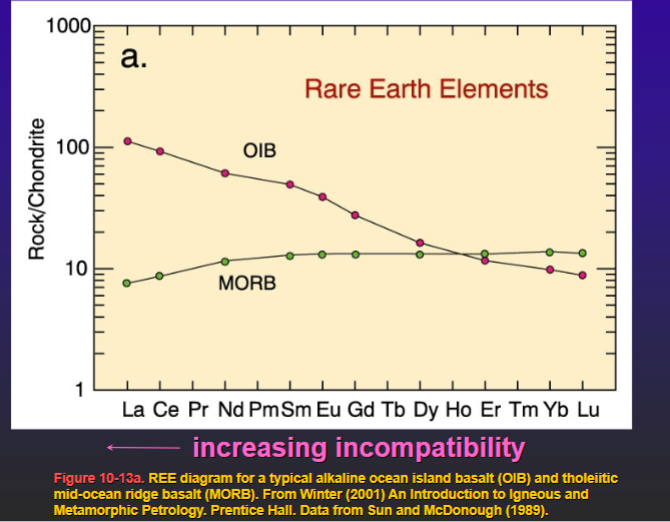
Spider diagram for oceanic basalts
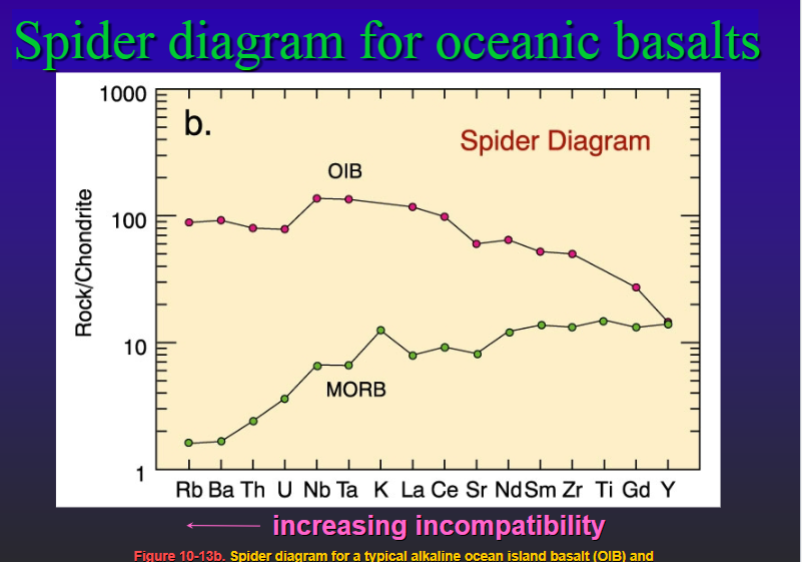
Review of Sr Isotopes
87Rb->87Sr
-Rb (parent) concentrated in enriched reservoir (incompatible)
-Enriched reservoir develops more 87Sr over time
-Depleted reservoir (less Rb) develops less 87Sr over time
Nd and Sr Isotopes of ocean basalts: “Mantle Array”
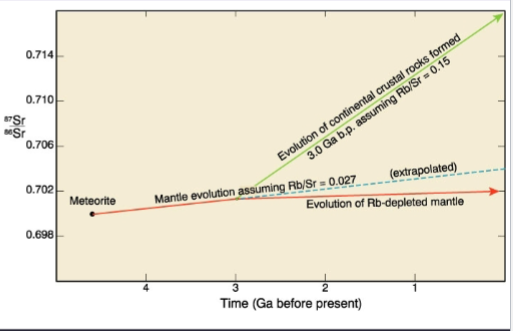
Sm-Nd: Evolution curve is opposite to Rb - Sr
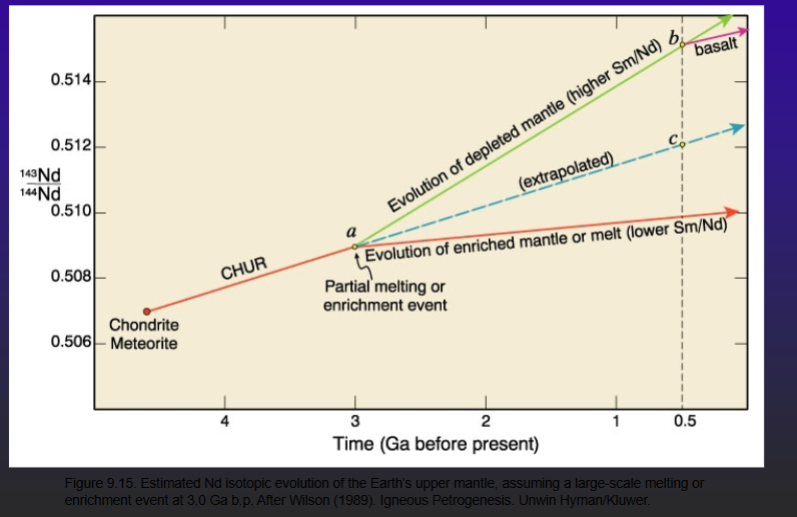
What conditions (chemical characteristics) are necessary for a magma to be considered a primary mantle melt?
Primary magmas:
-Formed at depth and not subsequently modified by FX or Assimilation
-Criteria
· Highest Mg# (100Mg/(Mg+Fe)) really -> parental magma
· Experimental results of Lherzolite melts
-Mg#= 66-75
-Cr> 1000 ppm
-Ni >400-500ppm
-Multiply saturated
-low % SiO2, highest Mg # (100Mg/(Mg+Fe))(parental magma)
-high extrusion temperature
Multiple saturation
-Low P
Ol then Plag then Cox as cool
70C T range
-High P
CPX then plag then Ol
-25 km get all at once
=multiple saturation
suggests that 25 km is the depth of last eq with the mantke
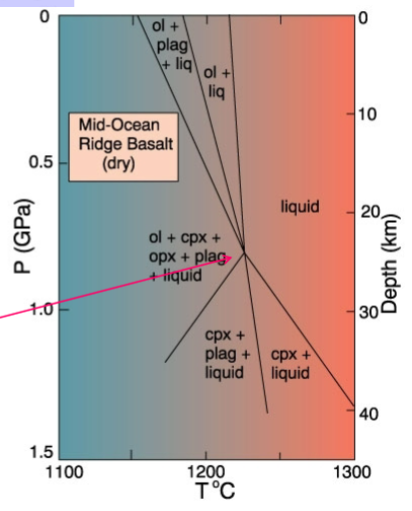
Heterogeneous Mantle Models
Magmatic product erupted at different settings are different in their concentrations of incompatible trace elements and are assumed to be derived from different regions of the mantle
What are the different “reservoirs”?
-Portions of mantle with different compositions
-Defined based on isotopes and trace elements
What is the scale (size) of heterogeneity?
-MORB- depleted mantle
-OIB- mixing of depleted mantle and three other reservoirs (dated 1-2 Ga old, but younger than the Earth)
-Some OIBs picked up a high He3/hE4 reservoir- primitive mantle?
Experiments on melting enriched vs. depleted mantle samples:
Depleted mantle
-tholeiite easily created by 10-30% PM
-more silica saturated at lower P
-difficult to generate alkaline basalt
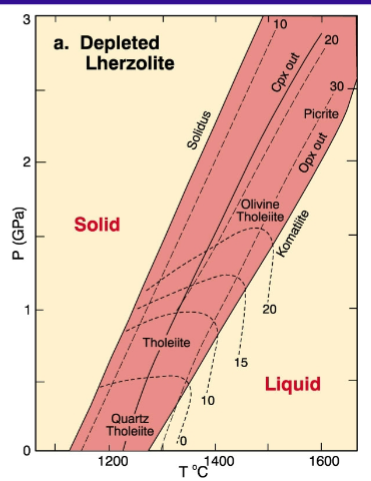
Experiments on melting enriched vs. depleted mantle samples:
2. Enriched Mantle
-tholeiites extend to higher P than for DM
-alkaline basalt field at higher P yet
and lower% PM
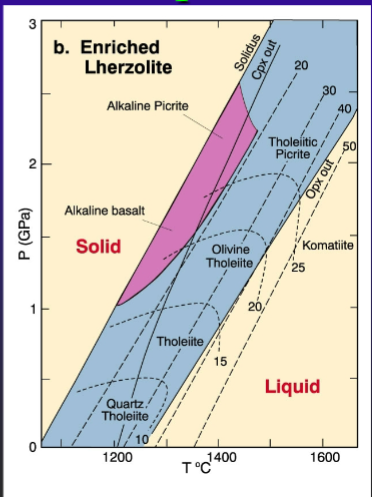
Summary
A chemically homogeneous mantle (unlikely) can yield a variety of basalt types
-Alkaline basalts are favored over tholeiites by deeper (hydrous or carbonated) melting and by low % PM
-Mantle is heterogeneous on many scales
-Different types of melting occurring in different tectonic environments result in significantly different rock series
How can mantle geochemical heterogeneity be preserved with mantle convection?
Mantle convection model needs to satisfy:
1) Different geochemical reservoirs
2) Seismic tomographic models
3) Thermal balance
4) Geodynamically feasible
Layered model
Many geochemists have favored
models in which the mantle is
chemically and dynamically
layered, with the upper mantle
being DMM and the lower mantle
being primitive (A).
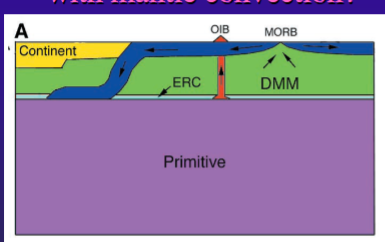
Geodynamic Model
Seismic tomography showing subducted
down-going oceanic plate in the lower mantle
Recent calculations at an Earth-like
convective vigor find that the lower mantle
becomes well mixed and outgassed over
billions of years
Primitive blob model
Plate tectonics introduces a toroidal
component to mantle flow, which can
cause chaotic mixing even in steady-
state 3D flows, resulting in efficient
mixing, although unmixed “islands” can
occur within efficiently mixed regions.
Blobs with a viscosity 10 to 100 times
that of normal mantle deform slowly
enough to remain unmixed after billions
of years
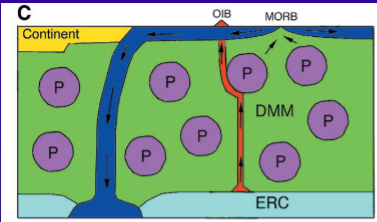
Complete recycling model
l D’’ layer at core-mantle
boundary
l Mixing of recycling lithosphere
and crust for High He3/4
reservoir
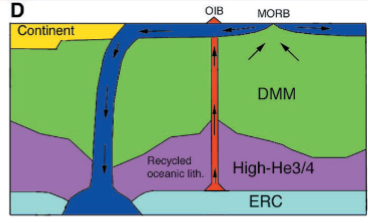
high-3He/4He reservoir (primative piles)
The high-3He/4He reservoir is a primitive,
primordial layer (containing the missing
heat-producing elements) with a deeper
boundary.
l primitive material forms a discontinuous
layer (E) consisting of two piles
corresponding to the two megaplumes
observed under Africa and the Pacific in
seismic tomographic models
undulating layer (deep primiatuve layer)
The second study proposed a global,
undulating layer of average thickness
1300 km (but varying by ;1000 km)
and constituting ;30% of mantle mass
(F), overlain by a recycled crust layer
Various mantle convection and reservoir models
